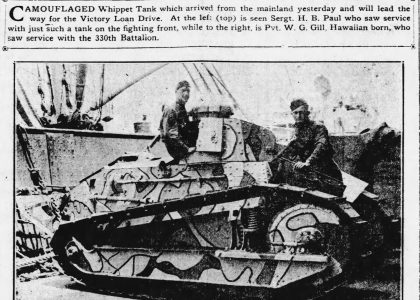Private Abraham Hauli: A Life from Hilo to Honolulu, Lost to Pneumonia in Service
Abraham Hauli was born on December 10, 1896, in the Waiākea area of Hilo, on Hawaiʻi Island, to Noelani Hauli and Opunui Kalihinui (U.S. Death Certificates, 1919). Like many young people of his time, Abraham’s early life reflected both the close-knit bonds of ʻohana and the transitions occurring across the islands. By the age of 14, he was no longer living with his parents but instead with extended family in Honolulu: his aunt Kuamoo Wai, cousins Tim Aken Wai and Haleakala Wai, and Haleakala’s husband, Hong Tai Wong, at 162 Kukui Street near River Street (U.S. Census, 1910).
In the years leading up to World War I, Abraham worked as a house painter in Honolulu. In 1917, he was living at 267 Vineyard Street and supporting his younger sister, Helen, who was still a minor at the time (U.S. Draft Registration Card, 1917–1918). That year, he was listed in the Honolulu City Directory under the name “Huuli,” employed as a painter for Stanley Stephenson and living at the corner of River and Kukui Streets—close to the same home where he had lived with his extended family earlier in the decade (City Directories, 1917).
Despite economic hardship and family responsibility, Abraham responded to the nation’s call. In July 1918, he was drafted into the U.S. Army and assigned to Schofield Barracks for training (Hauli, 1918).
But like so many young soldiers of the time, he never made it to the front. On January 10, 1919, Hauli was admitted to the Army hospital with pneumonia. He remained there for nearly a month, battling the illness without recovery. He died on February 7, 1919, at just 22 years old (Hawaiʻi Death Certificate, 1919).
His obituary, published in the Honolulu Advertiser, reported his death with quiet dignity. His passing was also listed in official government death records for the Territory of Hawaiʻi (Honolulu Star-Advertiser, 1919, February 12). His burial took place at Kawaiahaʻo Church Cemetery in Honolulu, where his grave bears a simple but telling inscription: “Brother Abraham Hauli.”
“The deceased was born at Hilo and was a private in the United States Army at the time of his death.”
— (Honolulu Star-Advertiser, 1919, February 12)
Hauli left behind no children of his own, but his memory lived on in his family’s naming traditions. His cousin Haleakala, with whom he had lived as a teenager, named her son “Abraham” in his honor. That namesake would pass the name to the next generation, creating a quiet legacy within the family that still remembered the young man who had died in uniform (Hauli Family Notes, 2025).
Private Abraham Hauli is one of many Native Hawaiian and local-born men who served during World War I despite Hawaiʻi still being a U.S. territory. His story is not only one of sacrifice, but also one of duty—leaving behind family, steady work, and the hope of a future in service of a broader cause.
Sources Cited
1910 United States Federal Census. (1910). U.S. Census Bureau.
City Directories, 1822–1995. (1917). Honolulu City Directory, “Huuli.”
Hauli, A. (1918). Draftees Called to Active Duty. [Newspaper clipping, user archive].
Hawaiʻi Death Certificate. (1919, February 7). Territory of Hawaii Department of Health Records, entry for Abraham Hauli.
Honolulu Star-Advertiser. (1919, February 12). Obituary: Abraham Hauli, p. 6.
U.S., World War I Draft Registration Cards, 1917–1918.


